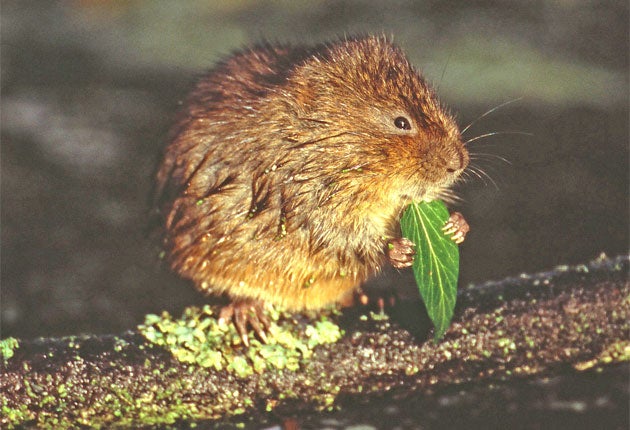How vegetarian voles got a taste for frogs' legs

Your support helps us to tell the story
From reproductive rights to climate change to Big Tech, The Independent is on the ground when the story is developing. Whether it's investigating the financials of Elon Musk's pro-Trump PAC or producing our latest documentary, 'The A Word', which shines a light on the American women fighting for reproductive rights, we know how important it is to parse out the facts from the messaging.
At such a critical moment in US history, we need reporters on the ground. Your donation allows us to keep sending journalists to speak to both sides of the story.
The Independent is trusted by Americans across the entire political spectrum. And unlike many other quality news outlets, we choose not to lock Americans out of our reporting and analysis with paywalls. We believe quality journalism should be available to everyone, paid for by those who can afford it.
Your support makes all the difference.Water voles have developed a penchant for one of the most rarefied delicacies of French cuisine – frogs' legs – conservationists have discovered.
The shy and furry rodents, immortalised by the character of Ratty in Kenneth Grahame's The Wind in the Willows, had previously been considered entirely herbivorous, subsisting on a diet of aquatic plants.
But ecologists from British Waterways found evidence of unusual eating preferences among water voles during a recent survey of the Kennet & Avon Canal in Berkshire. At several of the animals' "feeding stations" in the canalside vegetation were numerous dead frogs – with their legs removed.
"This is incredibly unusual behaviour," said British Waterways ecologist Robert Randall. "As far as we know this is the first recorded evidence we have of them eating frogs' legs, so it's a really exciting discovery."
Water voles need to eat about 80 per cent of their body weight in food every day and often bring their food to the water's edge, leaving the chewed-up remains in neat piles which ecologists use to monitor their eating patterns.
Mr Randall, who carried out the survey with fellow ecologist Oda Dijksterhuis, said: "We found a number of typical water vole feeding areas that were littered with dead frogs, minus their legs. As a water vole's diet is normally vegetarian, this rather gruesome scene wasn't what we'd expect to find at all.
"We're not really sure why it's happening, but as the evidence coincides with the water voles' breeding season, we think it may be that pregnant mothers are snacking on frogs' legs as they lack protein in their diet. We'll be keeping an eye on what happens next over the coming months." Mr Randall added: "There are reports of animals such as sheep, in some low-calcium environments like northern Scotland, eating the chicks of wading birds to get calcium out of their bones, but we think here it could be protein that they need."
Although there is no absolute proof that Ratty is responsible for the legless frogs – no one has seen it happen – Mr Randall thinks it is a "fairly strong assumption". He said: "There were no signs of rats or mink in the area, and anyway, they would have eaten the whole frog, not just bitten off the legs; and grass snakes, which eat frogs too, also swallow them whole."
It is possible that the leg of a frog is an item a water vole could manage, like the thick stem of a reed, whereas the whole body might be more difficult, Mr Randall said.
British Waterways, responsible for maintaining the 2,200-mile canal and river network in England, Wales and Scotland, carried out the survey last month before making improvements to the towpath between Hungerford and Newbury. Water voles, whose population has been ravaged by mink introduced from America in 1929, are Britain's most rapidly declining mammals. Their national population crashed from an estimated 8 million in 1960 to under 1 million by 2000, and their numbers may now be as low as 220,000. Efforts are under way to protect the animals and their habitats from further losses.
Join our commenting forum
Join thought-provoking conversations, follow other Independent readers and see their replies
Comments